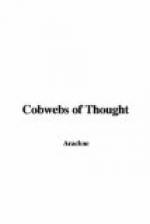There will remain the sense of benefit and stimulus from that large and frank nature, that large and pure utterance. Matthew Arnold gives three principal elements in her strain. Instead of the hopeless echo of unrealised ideas we hear from her the evolution of character: “1, Through agony, and revolt; 2, Through consolation from nature and beauty; 3, Through sense of the Divine (’Je fus toujours tourmente des choses divines’) and social renewal, she passes into the great life motif of her existence;” that the sentiment of the ideal life is none other than man’s normal life as we shall one day know it. Matthew Arnold saw George Sand in his enthusiastic youth when she was in the serenity and dignity of middle age at Nohant.
Browning came across her in her journalistic career in Paris, and he was not touched with the same admiration.
Mr. Chesterton suggests in his biography of the poet that Browning was conventional by nature—and through the greatness of his brain he developed. He certainly developed on many sides, but his development did not include admiration for George Sand and her circle. It was social tone, his biographer believes, more than opinions, which created this strong aversion in the author of “The Statue and the Bust.”
But Mrs. Browning, though her life had been mainly one long seclusion on her sofa, was unhampered by these conventional barriers. What she felt was the attraction of the massive and fascinating brain and heart of the great French woman, what she heard was “that eloquent voice,” what she saw was “that noble, that speaking head.” She had warm, quick sympathies and intuitional appreciations of genius. In regard to so wide and so complicated a character as George Sand’s, we cannot be astonished at finding very different judgments and impressions; indeed we are prepared to feel in all of them some note of inadequacy and of incompleteness. But in our relation to her as a Great Writer, of this, as readers, we are assured, we know that it is no common matter to have come into contact with so gifted and great a nature, with a genius that possessed “a current of true and living ideas,” and which produced “amid the inspiration of them.”




